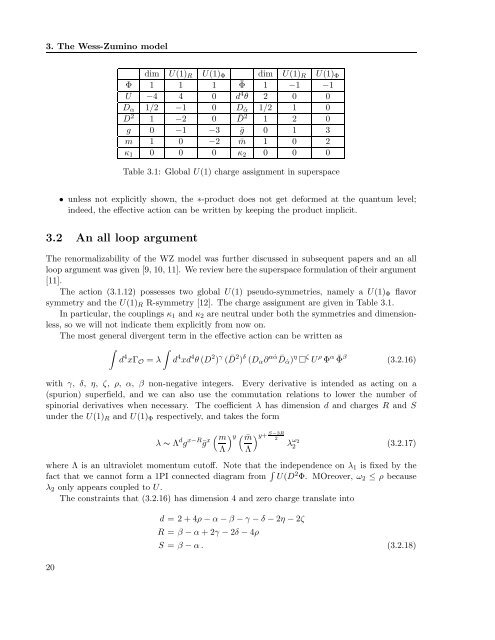Perturbative and non-perturbative infrared behavior of ...
Perturbative and non-perturbative infrared behavior of ...
Perturbative and non-perturbative infrared behavior of ...
Create successful ePaper yourself
Turn your PDF publications into a flip-book with our unique Google optimized e-Paper software.
3. The Wess-Zumino model<br />
dim U(1)R U(1)Φ dim U(1)R U(1)Φ<br />
Φ 1 1 1 ¯ Φ 1 −1 −1<br />
U −4 4 0 d 4 θ 2 0 0<br />
Dα 1/2 −1 0 ¯ D ˙α 1/2 1 0<br />
D 2 1 −2 0 ¯ D 2 1 2 0<br />
g 0 −1 −3 ¯g 0 1 3<br />
m 1 0 −2 ¯m 1 0 2<br />
κ1 0 0 0 κ2 0 0 0<br />
Table 3.1: Global U(1) charge assignment in superspace<br />
• unless not explicitly shown, the ∗-product does not get deformed at the quantum level;<br />
indeed, the effective action can be written by keeping the product implicit.<br />
3.2 An all loop argument<br />
The renormalizability <strong>of</strong> the WZ model was further discussed in subsequent papers <strong>and</strong> an all<br />
loop argument was given [9, 10, 11]. We review here the superspace formulation <strong>of</strong> their argument<br />
[11].<br />
The action (3.1.12) possesses two global U(1) pseudo-symmetries, namely a U(1)Φ flavor<br />
symmetry <strong>and</strong> the U(1)R R-symmetry [12]. The charge assignment are given in Table 3.1.<br />
In particular, the couplings κ1 <strong>and</strong> κ2 are neutral under both the symmetries <strong>and</strong> dimensionless,<br />
so we will not indicate them explicitly from now on.<br />
The most general divergent term in the effective action can be written as<br />
<br />
d 4 <br />
xΓO = λ d 4 xd 4 θ (D 2 ) γ ( ¯ D 2 ) δ (Dα∂ α ˙α D¯ ˙α) η ζ U ρ Φ α Φ¯ β<br />
(3.2.16)<br />
with γ, δ, η, ζ, ρ, α, β <strong>non</strong>-negative integers. Every derivative is intended as acting on a<br />
(spurion) superfield, <strong>and</strong> we can also use the commutation relations to lower the number <strong>of</strong><br />
spinorial derivatives when necessary. The coefficient λ has dimension d <strong>and</strong> charges R <strong>and</strong> S<br />
under the U(1)R <strong>and</strong> U(1)Φ respectively, <strong>and</strong> takes the form<br />
λ ∼ Λ d g x−R ¯g x m<br />
Λ<br />
y y+ ¯m<br />
Λ<br />
S−3R<br />
2<br />
λ ω2<br />
2<br />
(3.2.17)<br />
where Λ is an ultraviolet momentum cut<strong>of</strong>f. Note that the independence on λ1 is fixed by the<br />
fact that we cannot form a 1PI connected diagram from U(D 2 Φ. MOreover, ω2 ≤ ρ because<br />
λ2 only appears coupled to U.<br />
The constraints that (3.2.16) has dimension 4 <strong>and</strong> zero charge translate into<br />
20<br />
d = 2 + 4ρ − α − β − γ − δ − 2η − 2ζ<br />
R = β − α + 2γ − 2δ − 4ρ<br />
S = β − α. (3.2.18)
















